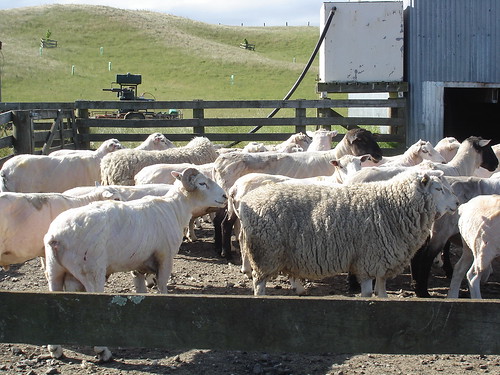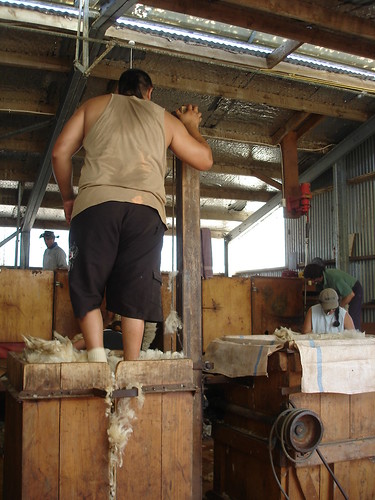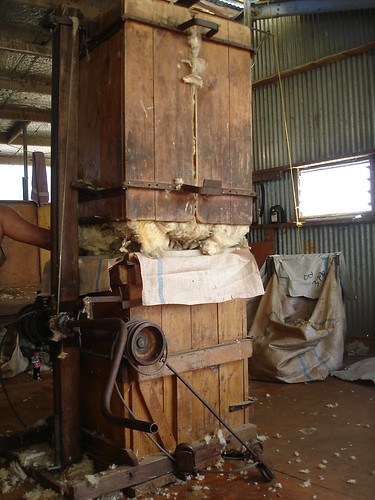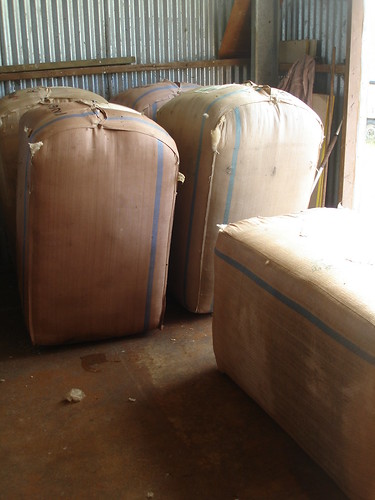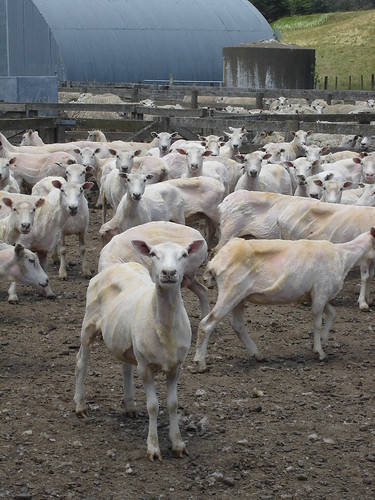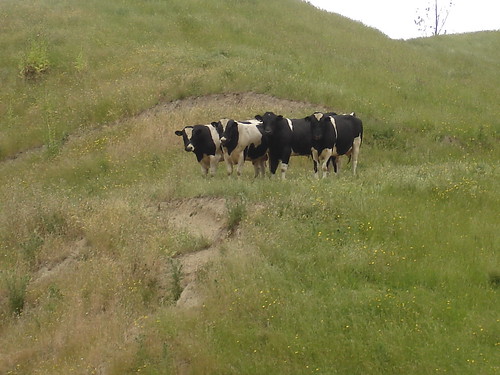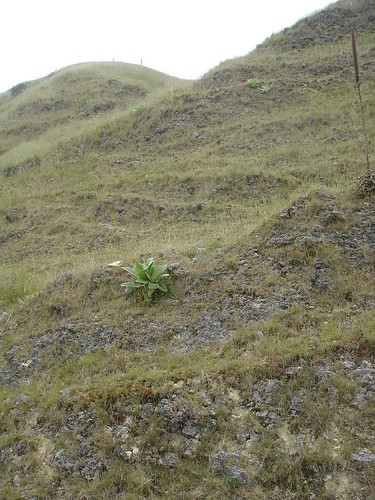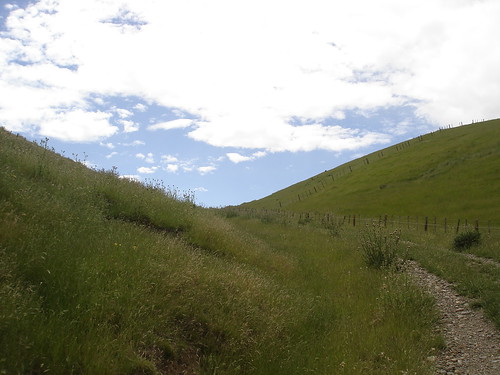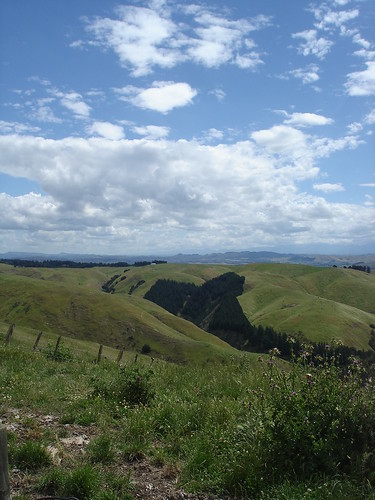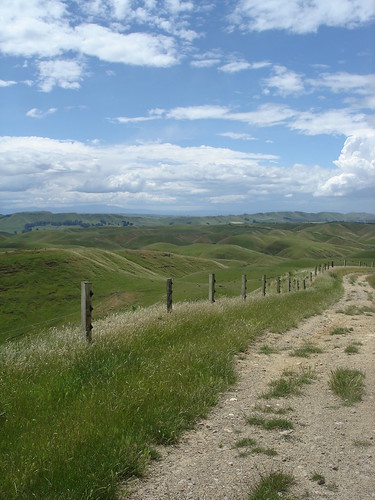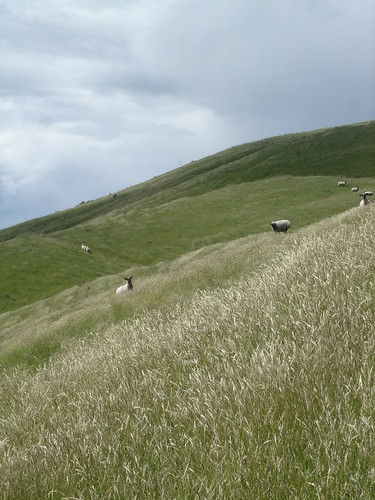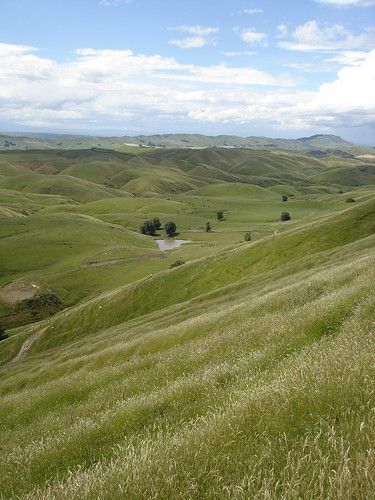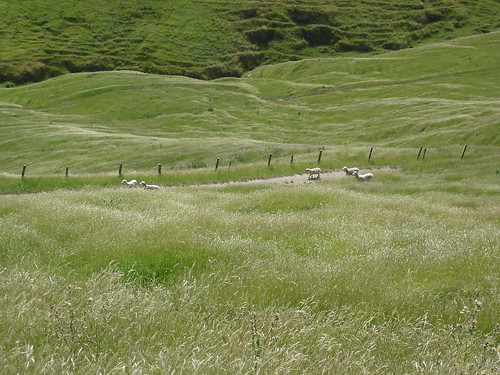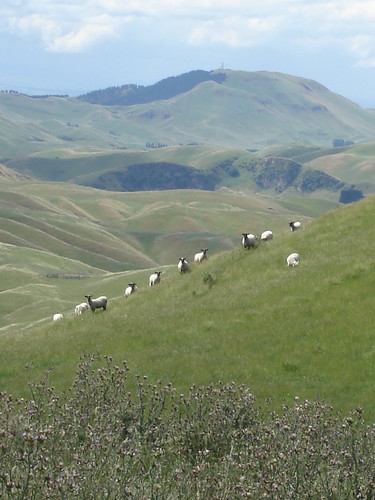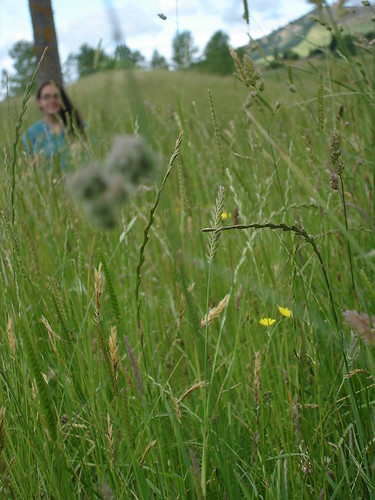
I have been sitting here for about ten minutes, trying to figure out how to start this blog post! It's been a month and a bit since I first made it to Hawke's Bay, and a week since I've moved off of Mangarara Station to a nearby farm. I know it's a bit early in the game for me to have found a favorite place in this country, but I might just be a tiny bit besotted with this area. Staying at Mangarara Station has definitely helped form that opinion in my mind!
I was trying to figure out how to introduce you to Mangarara, and thought the best way would be to take a little tour. So just imagine these shots from the back of a four-wheeler as Greg, the wonderful, incredibly knowledgeable, and really fun owner, blazes down the dirt road and across the paddocks with you, clinging madly to the scant framework and hoping you don't bounce off!
We start out at the little cabin where I stayed for most of my time at Mangarara. (Okay, so you don't need the four-wheeler for this bit.)

Every morning I would wake up to the birds flitting in and out of their nests in the vents. They liked to wake up much earlier than I did, but I don't think I could have chosen a better way to wake up! So I would stumble out of bed, bleary-eyed, and stand out on the porch to wake up fully.

As you can sort of see there, both the bedroom and the bath have full glass doors looking out into the lake paddock, the view I showed you last time. A couple days before I left, Greg moved a flock of sheep into the paddock, so my morning ablutions were often accompanied by a couple ewes and lambs looking quizzically over the fence.

(The sheep, having grown bored with my toothbrushing antics, head off to try out the kayaks.)
Once I'd woken up and had breakfast with Rachel, Greg's amazing, capable, and friendly wife, George, who had his sixth birthday while I was there, and Bill and Emma, the four-year-old twins, I would wander out to the backyard paddock to bottle-feed Cookies'n'Cream the lamb.

Lambs, like kid goats, wiggle far too much to take good pictures of! There were about six pet lambs in that paddock, including little Cookies here, whose mothers had either died or had abandoned them after birth, and so had needed to be hand-fed. The problem with this is, when you train sheep to be comfortable around humans, you lose any sort of ability to scare them into going where you want them. I was given the job of shifting them across the road to the lake paddock with the rest of that flock at one point, and so I set off with a smile and a borrowed pair of Wellies. How hard could it be? Three-quarters of an hour later, with no smile and lots of blisters from stumping around in those Wellies, I had gotten those lambs no farther than a continual brisk trot up and down the driveway. Finally Rachel got them to go through the gate by walking through it and making mommy-sheep noises. You win some, you lose some.
So once you've fed Cookies'n'Cream and she's wandered off to look pitiful as you cruise by on the four-wheeler:

The lake is on the right as you head down the road, and the pine forest rises on the left, home to the three opinionated chooks (chickens). On either side of the road are lovely, worn, sheep-bent wire fences, often with little clumps of stray wool still clinging to them:

(You better believe I stole some of that stuff.)
Once you make it back up to the Mangarara sign, you take a sharp left and head down the long, tree-lined way to the cattle yards. Here's where you're going to need to squint a bit, as the poplars are pollinating, and their seeds are swirling around like soft, delicate, and always-gets-in-your-eyes-while-you're-trying-to-drive-the-damn-four-wheeler snow. Greg told me that they call it "miff muff moof" after The Lorax, and that makes me very happy.
You'll take a right at the cattle yards, and as Greg shifts the four-wheeler into fifth gear, you'll whizz past the first mob of Wagyu beef cattle.

(I was literally whizzing past on the back of a four-wheeler while taking that photo; see how far I'll go for the sake of realism in this blog?)
Now, I am pretty ambivalent on cows; to be honest, I think they're too big for me to comfortably feel in charge of, so I haven't worked too hard to get to know them. But these guys are unnervingly smart, gorgeously svelte, and way too inquisitive for their own good. They like pulling down the electric fence, and so while Greg was sorting that out at one point, it was my job to keep them contained within one side of the paddock. Usually, cows will just back off, and stay away from you, especially if you're a stranger. But these guys were constantly nudging closer and closer to me to check me out, and even when I made Big Scary Noises (patented) they didn't stay off for long. Likewise, Greg drove me up to the top of one of the rises once, and I stayed with the four-wheeler while he took out some thistles. The entire mob of cattle came up the hill and surrounded me and the four-wheeler, nibbling on the seat and whuffling through the exhaust pipe. Part of me is daunted by their brazenness, and another part is impressed. Plus, I've heard they taste really good. So there you go.
Once you pass that first mob of cattle, the road will twist and wind among the paddocks and hills until you reach the sheep yards. I got to hang out and "help" during lamb drafting and weighing (don't know how much help I actually was, but I was enthusiastic!). The day I was helping, they were taking off the male lambs weighing over 30kg. However, they had a flock encompassing the length and breadth of sheep-kind: big, little, lamb, ewe, male, female. This is where the process of drafting comes in: the sheep get herded from the paddock into a series of ever-shrinking pens, until they are sent through a race that is only wide enough for one at a time:

At the head of that race are, in this case, three different doors to three different pens. As the sheep come up the race (my job was to make sure they kept moving, either by making Big Scary Noises again or by flipping the sheep around who was blocking the way), the person holding the doors will open the appropriate one--all male lambs this way, ewes and female lambs that way. From there, it felt a bit like an ever-more-specific series of Venn diagrams--male lambs definitely over 30kg that way, potentially over 30 that way, and definitely not over 30 that way. Then, after weighing the over 30s and the maybes (another series of pens and a race wide enough for one at a time, culminating in a scale with doors on either side), and tagging those over 30kg (the red paint in the picture above), the process begins again, drafting the tagged ones off from the rest. From there, those who needed to be crutched (shearing the dirty wool from around the bum) were drafted off from the clean ones. Finally, after crutching, all of them were let back into the paddock with their moms, that red tag indicating who would get drafted off when the process happened all over again the next morning when the lambs went off on their way to the works. It is exhausting, dusty, and very, very hot; I now have very silly tan lines on my brow from squinting in the sun all day. But it is also really fun. Once you get a flow going, where everyone from the herding dogs to the hapless WWOOFer to the experienced farmer on the drafting gates is focused, and the sheep are being only a bit recalcitrant, it turns into this lovely dance of dust, hooves, slamming gates, and warm, worn wood under your hands.
Once you've finished your day at the sheep yards, you have a choice of accommodation. You can head back up to the house and the cabin, where the kids will regale you with tales of Legos and Thomas the Tank Engine, you can take a nice soak in the bathtub with that magnificent view and a good book for company, or you can crack open a beer and sit on the porch with Atticus the cat. Or you can climb back on the four-wheeler, take a right out of the sheepyards, head out through two more paddocks, through a couple gates, and down along a ravine to the bush cabin. It's a small bunkroom with outdoor plumbing and no electricity built into one of the preserved sections of native bush at Mangarara:

The bullfrogs are pretty clear that the pond belongs to them, but they're relatively good about sharing. I spent a night out here during my second weekend on the farm, which was one of the busiest I've ever been involved in!
One of the things that Greg and Rachel have done so well on this farm is form partnerships that are mutually beneficial to both parties involved. The second weekend I was there was the fruit of one of those partnerships, this one with Air New Zealand. It apparently started when Greg called up and asked if he couldn't buy some trees with his air miles rather than plane tickets, and ended with Air New Zealand giving them a sizable grant to plant native trees at Mangarara as carbon offset for the airline. They've also been working with the Air New Zealand Green Team to set up "working holiday" corporate retreats for Air New Zealand employees, and this weekend was the very first. Fifty Air NZ employees from Auckland rocked up to the farm on Saturday morning, and they spent the weekend weeding around the sapling trees, grubbing thistles, eating unbelievable amounts of food (I'm now staying on the farm of Sandy, the lovely woman who catered the weekend and sent everyone home at least two kilos heavier), kayaking in the lake, and generally having the time of their lives.
My job for the weekend was General Helper to everyone involved, and I don't think I stopped running for most of the weekend! They had wine tastings, campfire sing-alongs and marshmallow roastings, a wonderful and hilarious storyteller's show (with lots of audience participation and alcohol), and, the culmination of the weekend, an Agri-sports event on Sunday. The events ranged from archery, to putting in a fence-post, to setting up an electric fence, to sheep drafting, to quizzes on native flora and strange farm equipment, to my event, sheep weighing. Now, each team of five was originally supposed to guess a group of five sheep's weight, then put them through the race to the scale to find out the real weight. However, these sheep were straight off the grass, very frisky, and were having none of that. Greg decided it would be best just to have the teams guess the weight, but I thought there needed to be a little more to it than that. So I decided that each team had to herd one of their members through the race and onto the scale! Extra points for acting properly sheep-like. The easy part was getting them through the race and onto the scale; the hard part was getting them out again! I deeply, deeply regret the absence of my camera.
Once the Air NZ people left, things calmed down into a lovely schedule at Mangarara. In addition to working out with the stock, I spent lots of time hanging out with the kids. I've never had a whole lot to do with kids that young, and it was a quick learning process, let me tell you! But we had a great time together, and I taught them to make fairy houses, so there's a little bit of Maine hanging out in that pine wood behind the house. And I know you're not supposed to have favorites, but every time Bill said, very seriously, "oh, crumbs!" with his little Kiwi accent and lisp ("oh, cwumbth!"), my heart melted and I made plans to stash him in my suitcase. I also had a wonderful, wonderful time just chatting with Rachel, as well, whose sense of humor and joie d'vivre was a hell of a lot of fun when we got caught out in a downpour while shifting cattle and repairing an electric fence. Greg continually amazed me with his energy and big plans--not only did he have big plans, but he goes on five hours of sleep to make sure he accomplishes them! He also gave me a fantastic crash course on climate change and world development through the films,
The Age of Stupid and
Food Inc., and the book,
Blessed Unrest, all of which I would recommend highly. Just not all at once, unless you have Ben & Jerry's or alcohol to make you feel less depressed at the end! Both from these sources and from the way they market themselves on this farm, I'm looking at the world through very different eyes after being at Mangarara. And I am liking the view.
So that's a brief glimpse into my time at Mangarara, but nothing can impress just how wonderful and breathtakingly gorgeous it was. I truly am besotted with Hawke's Bay, this region of the country, and was glad of Sandy's offer to take me on for a few weeks. Even better, she also has a beach house about half an hour away at Kairakau Beach, one of the most heart-rendingly beautiful places I've ever been. I promise scads of pictures next time I post! Perhaps if I camp out on the beach, they won't make me ever leave. . .
I will leave you with pictures of a storm coming over the lake during the golden hour before twilight at Mangarara. 'Til next time!





 When the shearers arrived, they started setting up, and Greg and I went back up to the top of the driveway to collect the rams for shearing as well. Greg gave me a four-wheeler and the task of getting the rams back to the sheepyards, which I was more than happy to do. I missed tearing around on four-wheelers!
When the shearers arrived, they started setting up, and Greg and I went back up to the top of the driveway to collect the rams for shearing as well. Greg gave me a four-wheeler and the task of getting the rams back to the sheepyards, which I was more than happy to do. I missed tearing around on four-wheelers! Look at 'em go! Except, as evidenced by the fact that I could take pictures and drive a four-wheeler at the same time, here's a shot of the spedometer:
Look at 'em go! Except, as evidenced by the fact that I could take pictures and drive a four-wheeler at the same time, here's a shot of the spedometer: Four kilometers an hour. Yeeee haw.
Four kilometers an hour. Yeeee haw. Three of the men were up on the platform, doing the actual shearing, and the three women stood on the floor below, skirting the fleece as it came off, sorting the belly wool, neck wool, and dags into three different piles before taking the remaining fleece to the wool baler, that contraption in the center of the photo there. The sheep on this farm are Romney, Finn, Texel, and Perendale, all varieties that have been bred for meat rather than wool (even though I think the wool is really lovely!). So, rather than selling each fleece individually, the wool gets packed into bales and sent to an auction or an agent who will buy it for carpet wool.
Three of the men were up on the platform, doing the actual shearing, and the three women stood on the floor below, skirting the fleece as it came off, sorting the belly wool, neck wool, and dags into three different piles before taking the remaining fleece to the wool baler, that contraption in the center of the photo there. The sheep on this farm are Romney, Finn, Texel, and Perendale, all varieties that have been bred for meat rather than wool (even though I think the wool is really lovely!). So, rather than selling each fleece individually, the wool gets packed into bales and sent to an auction or an agent who will buy it for carpet wool.